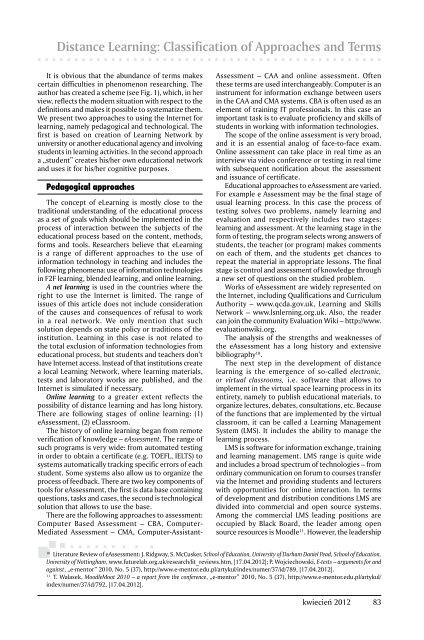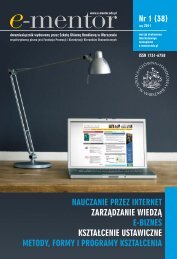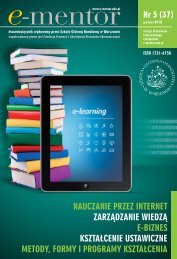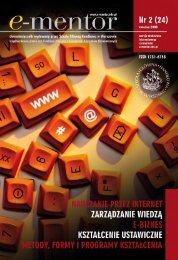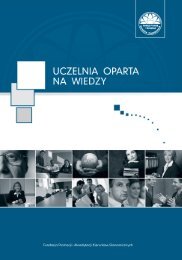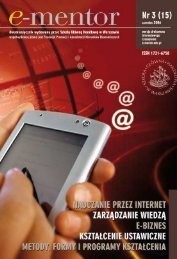metody, formy i programy ksztaÅcenia - E-mentor
metody, formy i programy ksztaÅcenia - E-mentor
metody, formy i programy ksztaÅcenia - E-mentor
You also want an ePaper? Increase the reach of your titles
YUMPU automatically turns print PDFs into web optimized ePapers that Google loves.
Distance Learning: Classification of Approaches and TermsIt is obvious that the abundance of terms makescertain difficulties in phenomenon researching. Theauthor has created a scheme (see Fig. 1), which, in herview, reflects the modern situation with respect to thedefinitions and makes it possible to systematize them.We present two approaches to using the Internet forlearning, namely pedagogical and technological. Thefirst is based on creation of Learning Network byuniversity or another educational agency and involvingstudents in learning activities. In the second approacha „student” creates his/her own educational networkand uses it for his/her cognitive purposes.Pedagogical approachesThe concept of eLearning is mostly close to thetraditional understanding of the educational processas a set of goals which should be implemented in theprocess of interaction between the subjects of theeducational process based on the content, methods,forms and tools. Researchers believe that eLearningis a range of different approaches to the use ofinformation technology in teaching and includes thefollowing phenomena: use of information technologiesin F2F learning, blended learning, and online learning.A net learning is used in the countries where theright to use the Internet is limited. The range ofissues of this article does not include considerationof the causes and consequences of refusal to workin a real network. We only mention that suchsolution depends on state policy or traditions of theinstitution. Learning in this case is not related tothe total exclusion of information technologies fromeducational process, but students and teachers don’thave Internet access. Instead of that institutions createa local Learning Network, where learning materials,tests and laboratory works are published, and theInternet is simulated if necessary.Online learning to a greater extent reflects thepossibility of distance learning and has long history.There are following stages of online learning: (1)eAssessment, (2) eClassroom.The history of online learning began from remoteverification of knowledge – eAssessment. The range ofsuch programs is very wide: from automated testingin order to obtain a certificate (e.g. TOEFL, IELTS) tosystems automatically tracking specific errors of eachstudent. Some systems also allow us to organize theprocess of feedback. There are two key components oftools for eAssessment, the first is data base containingquestions, tasks and cases, the second is technologicalsolution that allows to use the base.There are the following approaches to assessment:Computer Based Assessment – CBA, Computer-Mediated Assessment – CMA, Computer-Assistant-Assessment – CAA and online assessment. Oftenthese terms are used interchangeably. Computer is aninstrument for information exchange between usersin the CAA and CMA systems. CBA is often used as anelement of training IT professionals. In this case animportant task is to evaluate proficiency and skills ofstudents in working with information technologies.The scope of the online assessment is very broad,and it is an essential analog of face-to-face exam.Online assessment can take place in real time as aninterview via video conference or testing in real timewith subsequent notification about the assessmentand issuance of certificate.Educational approaches to eAssessment are varied.For example e Assessment may be the final stage ofusual learning process. In this case the process oftesting solves two problems, namely learning andevaluation and respectively includes two stages:learning and assessment. At the learning stage in theform of testing, the program selects wrong answers ofstudents, the teacher (or program) makes commentson each of them, and the students get chances torepeat the material in appropriate lessons. The finalstage is control and assessment of knowledge througha new set of questions on the studied problem.Works of eAssessment are widely represented onthe Internet, including Qualifications and CurriculumAuthority – www.qcda.gov.uk, Learning and SkillsNetwork – www.lsnlerning.org.uk. Also, the readercan join the community Evaluation Wiki – http://www.evaluationwiki.org.The analysis of the strengths and weaknesses ofthe eAssessment has a long history and extensivebibliography 10 .The next step in the development of distancelearning is the emergence of so-called electronic,or virtual classrooms, i.e. software that allows toimplement in the virtual space learning process in itsentirety, namely to publish educational materials, toorganize lectures, debates, consultations, etc. Becauseof the functions that are implemented by the virtualclassroom, it can be called a Learning ManagementSystem (LMS). It includes the ability to manage thelearning process.LMS is software for information exchange, trainingand learning management. LMS range is quite wideand includes a broad spectrum of technologies – fromordinary communication on forum to courses transfervia the Internet and providing students and lecturerswith opportunities for online interaction. In termsof development and distribution conditions LMS aredivided into commercial and open source systems.Among the commercial LMS leading positions areoccupied by Black Board, the leader among opensource resources is Moodle 11 . However, the leadership10Literature Review of eAssessment: J. Ridgway, S. McCusker, School of Education, University of Durham Daniel Pead, School of Education,University of Nottingham, www.futurelab.org.uk/research/lit_reviews.htm, [17.04.2012]; P. Wojciechowski, E-tests – arguments for andagainst, „e-<strong>mentor</strong>” 2010, No. 5 (37), http://www.e-<strong>mentor</strong>.edu.pl/artykul/index/numer/37/id/789, [17.04.2012].11T. Walasek, MoodleMoot 2010 – a report from the conference, „e-<strong>mentor</strong>” 2010, No. 5 (37), http://www.e-<strong>mentor</strong>.edu.pl/artykul/index/numer/37/id/792, [17.04.2012].kwiecień 2012 83


